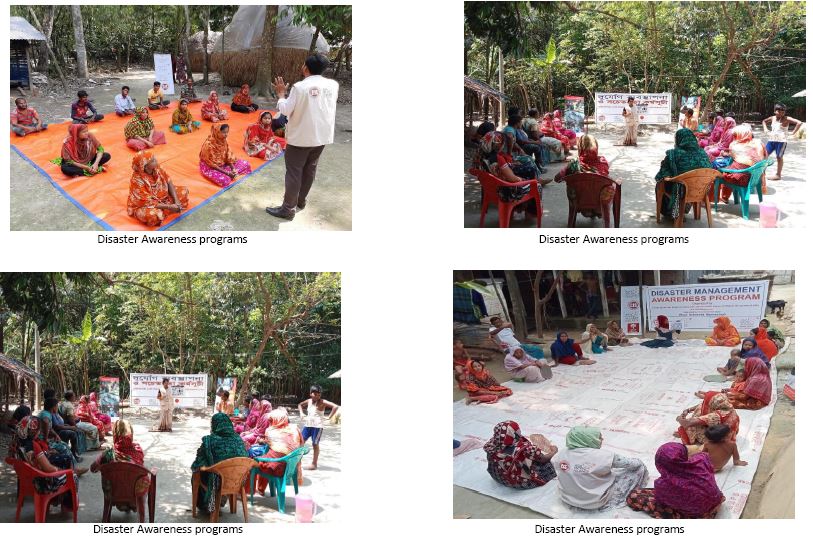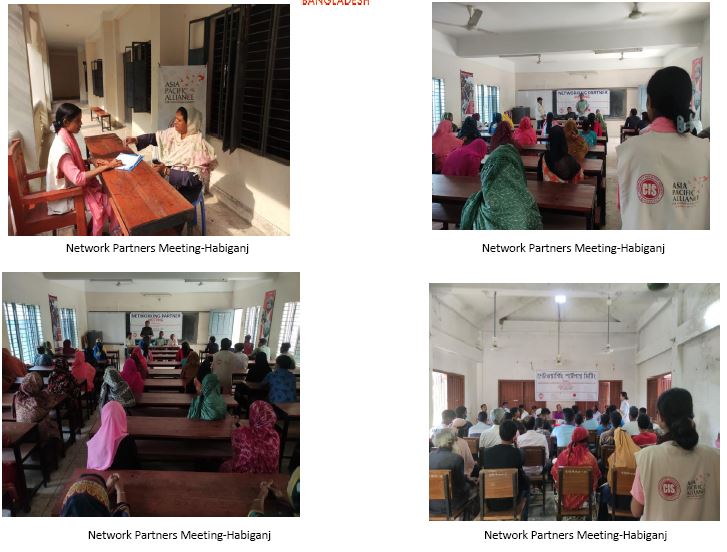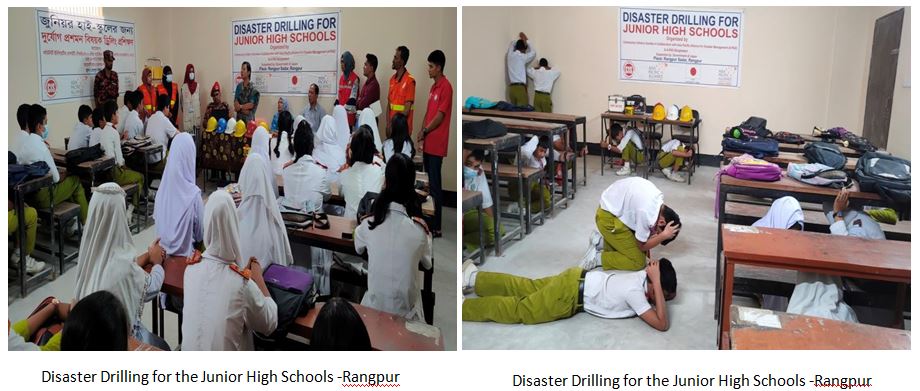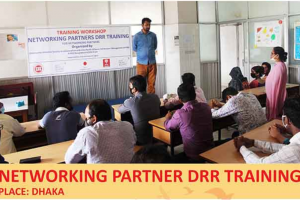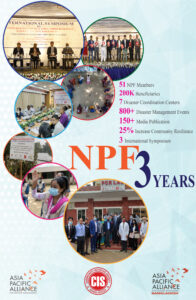Project Title: Strengthening Capacity for Sustainable Disaster Management Network by involving multi-sectoral platform Project Period: 17 January, 2023 – 16 January, 2024 (12 month)
- Project Activities and Accomplishments
Bangladesh is one of the most vulnerable countries to natural disasters and, due to climate change; we are facing natural disasters almost every year. Combined with the country’s geographical location, topography, and dense population, disaster events often result in high loss of life and economic loss, though Bangladesh has been successfully reducing the loss of human lives over the years. The frequency and intensity of natural disasters have been increased in recent years due to climate change. The climatic events have serious consequences on broad agricultural sectors, food security, water, health and sanitation and leave serious impacts on life and livelihood of the communities. But so far we have limited disaster risk related data to understand the depth of household and population characteristics and loss sustained by the community at the household levels.
A-PAD Bangladesh started project from January 2023 and presently continue it 17 January 2023 to build up capacity on disaster management. It communicates with the different sectors like local community, community leaders, stakeholders, GOVT. officials continuing training on disaster management. To hold training program A-PAD Bangladesh staff organized small community meeting to sharing ideas on disaster and introduced them about A-PAD Bangladesh activity. A-PAD Bangladesh working 8 divisional areas.
There are 1 health workers in each divisions whose are doing home visit and aware the local community about basic disaster awareness. The health workers gave basic ideas about disaster management. A-PAD Bangladesh working at the rural areas. If there would be any directions or announcement from GOVT. or any disaster related news has been published the health workers delivered the message to the local community. Total 4,866 persons were benefited from A-PAD Bangladesh on April 2023.
A-PAD Bangladesh attended coordination meeting at the 8 divisions in Office of Deputy Commissioner. At that meeting different NGOs had joined and explained their activities. Besides this what will be the next activities of the GOVT. and NGOs were discussed at that meeting.
1. To manage the emergency disaster management coordination centers in disaster-prone areas (Outcome 1) The disaster management coordination center in disaster vulnerable areas established in this project (3 year project) functions as a disaster response base in each region, and contributes for preventing the spread of health damage to local residents and community-led disaster risk reduction measures. | ||
Activities | Outcome Indicators to Measure Results: | Project Status: Achievements vs Outcome: If the activity is behind the schedule, please write the reason. |
1-1 Operation of Emergency Disaster Management Coordination Centers Beneficiaries: 10 people x 25 days x 8 divisions x 12 months = 24,000 people 50 people x 8 campaign x 12 months = 4,800 people | 【Indicators of Outcome】 1-1: The disaster response management centers in 8 places (Dhaka, Chattagram, Rajshahi, Khulna, Barisal, Sylhet, Rangpur and Mymensingh division) will be utilized and the necessary equipment for emergency health care will be prepared. We will establish a new emergency disaster management coordination center in Mymensingh division. The center will function as a resource center for sharing information on disasters and will be used as a venue for strategic planning meetings, training and workshops. The staff members including doctors and nurses visit the villages and carry out awareness activities related to emergency health measures, public health and disaster prevention for local residents, and ensure that each local resident takes appropriate preventive measures. | Total 3,090 people visited to the Disaster Management Coordination Center to discuss about disaster preparedness and health related issues. Dhaka: 390 Persons Cox’s Bazar: 400 Persons Pabna: 420 Persons Bagerhat: 405 Persons Patuakhali: 385 Persons Habiganj: 380 Persons Rangpur: 390 Persons Netrokona: 320 Persons Total = 3,090 Persons |
1-2 Disaster Management Awareness program Beneficiaries:15 participants x 3 sessions x 8 divisions x 12 months = 4,320 people | A-PAD Bangladesh conducted Disaster Management Awareness programs at the 8 divisional areas where 391 persons have participated. Total 3 times training organized at each divisional areas. Dhaka:15 Participantsx 3 Sessons= 45+4=49 Participants | |
|
(Indicator: number of visitors, record of services provided)
1-2: The PCR test lab installed in the previous project will continue to operate. In the first year of the project, testing will be conducted only for COVID-19. From the second year onwards, it will be expanded to other infectious diseases (tuberculosis, measles, hepatitis) according to the needs of local residents. (Indicator: number of tests, report of test results) | Cox’s Bazar: 15 Participantsx 3 Sessons= 45+2=47 Participants Pabna: 15 Participantsx 3 Sessons= 45+6=51 Participants Bagerhat: 15 Participantsx 3 Sessons= 45+4=49 Participants Patuakhali: 15 Participantsx 3 Sessons= 45+7=52 Participants Habiganj: 15 Participantsx 3 Sessons= 45+3= 48 Participants Rangpur: 15 Participantsx 3 Sessons= 45+2=47 Participants Netrokona: 15 Participantsx 3 Sessons= 45+3=48 Participants |
1-3 Operation of PCR lab Beneficiaries: 15 people x 25 days x 12 months = 4500 people(Monthly Goal: 15 persons x 25 days = 375 persons) |
A-PAD Bangladesh established PCR Lab for COVID-19 test. In Bangladesh number of COVID-19 patients has average in number. In April 2023 total 430 COVID-19 test has been done | |
2 Strengthening the disaster response platform network (Outcome 2) A-PAD BGD, NPF for disaster reduction and disaster response through collaboration between multi-sectors, will be established and expanded, and the disaster prevention and disaster capacity of its member organizations will be strengthened. | ||
2-1 Network partner meeting Participants : 100 people x 5 villages x 8 divisions = 4000 | 【Indicators of Outcome】 2-1 Strategies, mechanism and action plan meeting among networking partners and local communities | A-PAD Bangladesh conducted Network Partner Meeting at the Habiganj. Total 500 participants joined at the meeting. 24 April 2023, Richi, Habiganj, Total Participants 100 + 3 Participants |
people | will be held to support the building of disaster cooperation framework.
2-2 For the aim of awareness and increase the knowledge on disaster preparedness and management among the local community, we will organize different rally and meeting on the disaster preparedness and SDGs related national/international days like 05 November World Tsunami Awareness Day, 13 October Disaster Risk Reduction Day, 22 April Earth Day and 16 December Victory Day (National).
2-3 For the aim of strengthening of partner organizations, disaster risk reduction (DRR) training will be held. The training contents includes community-based disaster risk management, planning DRR strategies, and risk analysis that effectively identifies hazards, capacities and vulnerabilities. (Indicator: Partner organizations)
2-4 In this seminar, participants from various fields will be invited to exchange opinions and discuss ways to discover innovations related to DRR proposed by community residents and local companies and realize ideas and inventions. | 26 April 2023, Gopaya, Habiganj, Total Participants 100 + 2 Participants 27 April 2023, Poil, Habiganj, Total Participants 100 + 5 Participants 29 April 2023, Teghoria, Habiganj, Total Participants 100 + 3 Participants 30 April 2023, Vadoy, Habiganj, Total Participants 100 + 2 Participants
The meeting aimed to bring together stakeholders from different sectors, including government agencies, non- governmental organizations, community leaders, and other relevant parties, to build a strong network for disaster management in the region. Effective disaster management requires a coordinated effort from all stakeholders, and the Networking Partners Meeting provided an opportunity to share ideas, discuss best practices, and establish a framework for coordinated action.
The Networking Partners Meeting likely included presentations, discussions, and workshops on various topics related to disaster management, such as risk assessment, emergency response planning, and communication strategies. Participants had the opportunity to network and build relationships with other stakeholders, potentially leading to future collaborations and partnerships. |
| (Indicator: To create innovative solutions, we aim to create a successful model for disaster response by combining technology and knowledge that transcends fields and innovating)
2-5 The international symposium will be held in Dhaka to widely share the cooperation between multi-actors at the central and regional levels in Bangladesh and the progress of the emergency health response system among participants who are involved in disaster response from inside and outside Bangladesh. International experts will be dispatched from A-PAD member countries to introduce advanced cases of NPF in each country. (Indicator: The international symposium will be held for a total of three days, one day for field trips (field visits), one day for pre-meetings, and one day for international symposiums.) | 1. Building relationships: The primary objective of networking partners meeting is to build relationships between various individuals, businesses, organizations, or groups. It provides an opportunity to meet new people and establish connections with them, which can lead to potential collaborations, partnerships, or business opportunities in the future.
2. Sharing information: Networking partners’ meeting is also a platform for sharing information about products, services, or ideas. Participants can exchange knowledge, insights, and experiences about their respective fields, which can help them improve their businesses or personal ventures.
3. Exploring opportunities: Networking partners meeting is an ideal platform for exploring new opportunities. Participants can learn about new market trends, potential investors, or business partners, and explore ways to leverage those opportunities.
4. Building trust: Networking partners meeting helps build trust between participants. By meeting in person or virtually and engaging in discussions, participants can establish trust with each other, which can lead to future collaborations and partnerships. |
|
|
5. Developing skills: Networking partners meeting provides an opportunity for participants to develop their skills, including communication, negotiation, and presentation skills. Participants can learn from each other and improve their skills, which can benefit their personal and professional lives. |
2-2 Disaster Preparedness Campaigns
Participants:100 people x 2 times x 8 divisions = 1,600 people |
| |
2.3 Network Partners Capacity Strengthening (DRR) Participants:30 people x 2 org x 8 divisions x 2 times =960 people | A-PAD Bangladesh organized NetworkPartners Capacity Strengthening (DRR) Training at Bagerhat. 05-06 April 2023, Bagerhat, Total Participants 30 + 5 Participants Bagerhat District is a district in Southwestern Bangladesh. It is a part of the Khulna Division. The total area of Bagerhat is 3959.11 square kilometres (1528.62 square miles) and the population is 1,476,090. Not only poverty and political turmoil had been devastating the development of Bangladesh but this country with the highest density of population is also the most disaster-prone country in the world. 80% of the population lives in rural areas.CIS conducted a 2 days training program in Bagerhat on |
|
| Networking Partners Capacity Strengthening DRR. In this training program, Gonoshasthaya Kendra and Sheba Manab Kallyan Kendra SMKK joined. Gonoshasthaya Kendra works on clean water, Sanitation. Md Aslam Hossain from Gonoshasthaya Kendra shared that the Bagerhat district is one of the disaster-prone areas in the south part of Bangladesh. For geographic location and weather conditions, cyclones, tidal floods, erratic rainfall, cold wave, arsenic contamination, and tornado are common in this area. We need to take proper steps for human life in Bagerhat as due to geographical location people don’t get safe drinking water and this salinity causes health-related issues for Pregnant women especially. So we should think of innovative solutions which can provide this area, people. Also added that The coastal environment has an important relationship with human health and quality of life among the coastal communities. The environment influences the health of the population in various ways both positively and negatively. Ecological factors such as extreme natural calamities, habitat modification, and water pollution in these areas can lead to serious diseases, injuries and inadequate nutrition. so we need to keep in mind that for people better life along with disaster management, we need to take care of the health sector also. |
2-4 Seminar for Developing New Disaster Prevention Solutions Participants:40persons x 8 divisions x 2times =640 participants |
| A-PAD Bangladesh organized seminar at 3 divisional areas in Dhaka, Barishal and Khulna. 40 persons had joined in each seminar. 08-09 April 2023, Dhaka, Total Participants 40 + 4 Participants 17-18 April 2023, Patuakhali, Total Participants 40 + 5 Participants 26-27 April 2023, Bagerhat, Total Participants 40 + 2 Participants In DRR fields, many innovations have been implemented and proven their usefulness and effectiveness. To further promote DRR innovations, the types of DRR innovations that are most effective and useful for improving current DRR capacities must be understood. The Disaster Management Vision of the Government of Bangladesh is to reduce the risk to people, especially the poor and the disadvantaged, from the effects of natural, environmental and human-induced hazards, to a manageable and acceptable humanitarian level, and to have in place an efficient emergency response system. CIS Conducted a two days Seminar in Dhaka on Developing New Disaster Prevention Solutions. As one of the most disaster-prone cities in the world, the country’s capital, Dhaka, is particularly experienced in disaster risk management. However, it remains considerably exposed to the impact of earthquakes due to rapid urbanization and limited open |
|
| spaces for evacuation. These factors, coupled with the size and density of the population, considerably increase the risk of injuries and fatalities, especially since the occurrence of an earthquake in a location like Dhaka cannot be predicted with precision. Nevertheless, disaster preparedness techniques help to save lives and minimize destruction within the city’s limits. Building resilience is a long-term process that needs to be context-appropriate and embedded in national policies, strategies and frameworks – an important precondition for sustainable results. CIS Conducted a two days Seminar in Galachipa on Developing New Disaster Prevention Solutions for Galachipa as the season the cyclone is here. CPP is a world- renowned program that has been functioning since 1972 and currently covers at-risk areas within 13 coastal districts of Bangladesh with the support of over 55,000 CPP volunteers, who provide early warning messages to their communities in order they can take early action.in this Seminar there was a discussion on overall disaster and Cyclone. The CPP team was also there and they shared that Due to geographical conditions, Climate Change and the history of Cyclones in Bangladesh. Bangladesh has been more and more prone to Cyclones. The mission of CPP is To minimize the loss of lives and damage of properties in cyclones by strengthening the capacity in disaster |
|
| management of the coastal people of Bangladesh. They Highlighted that Before the cyclone season (April – May and October- November) volunteers arrange rallies at the grass root level of the CPP command area. They also encouraged people to join them during the time of emergency so this will help them to reduce the loss of lives and loss of property. Disaster management plays an integral role in keeping communities safe. It involves coordinating the resources, such as pollution control systems, and responsibilities, such as following best practice policies, needed to prevent, prepare for, respond to, and recover from emergencies. The development of a safe and habitable coastal zone is a longstanding priority for Bangladesh. Spanning more than 580 kilometres and housing more than a quarter of the country’s population, the area is key to its social, economic, and environmental well-being. But it remains extremely vulnerable to climate-related hazards such as cyclones, storm surges, coastal erosion, and sea level rise. CIS Conducted a two days Seminar in Bagerhat on Developing New Disaster Prevention Solutions. The main focus was on saving the lives of those at risk from cyclones and storms while providing safe schools for children in the communities most vulnerable to natural hazards. For Bagerhat we need to build climate resilience through multipurpose cyclone shelters, embankments, early |
|
| warning systems, weather services, and afforestation. Although there has been significant progress, with the coastal population and economy expected to grow, and the intensity and magnitude of extreme events projected to increase due to climate change, hazard impacts still pose a great threat to the development ambitions of the country. |
2-5 International Symposium on DRR
Participants:200 persons |
| |
3. Strengthening disaster resilience of local communities
(Outcome 3) Disaster response capacity building of local community level in Health and hygiene field | ||
3-1 a) ) Workshop on Disaster Management and Emergency Health Response
Participants:40 persons x 8 divisions x 2 times = 640 persons | 【Indicator of Outcome】 3-1 a) Workshops will be held to understand emergency disaster preparedness, health response and hygiene needs in communities, schools and homes and to learn how to respond during emergencies. Networks of stakeholders will be built through the workshop.
(Indicator: Local citizens, Community leaders, Local NGO, Private sector workers) | A-PAD Bangladesh organized Workshop on Disaster Management and Emergency Response at 2 divisional areas Mymensingh and Rajshahi. 09-10 April 2023, Mymensingh, Total Participants 40 + 5 Participants 16-17 April 2023, Dhaka, Total Participants 40 + 2 Participants To build capacity for emergency response during and after a disaster CIS conducted a Training program in Barhatta, Netrokona on Disaster Management and Emergency Health Response. The training was held on 09.10 April 2023. 1st Day |
|
b) Workshop for healthworkersfrom local organizationswillbeheld to understand emergency health and hygieneneeds and learn how to respond to emergencies. The healthworkerswhofinishedthis trainings are supposed to becomemember of disastervolunteerrescue team in the activity. | the topic was How to reduce the effect of Heat Waves. As a result of Climate Change at present, Bangladesh is facing heat waves at an extreme level. There was a discussion on what is the best advice for staying safe during a heat wave. As during the heaving wave to protect oneself one should follow some points.
Ø Move to the coolest room in the home, especially at night. Ø If it is not possible to keep your home cool, spend 2-3 hours of the day in a cool place (such as an air- conditioned public building). Ø Avoid going outside during the hottest time of the day. Ø Avoid strenuous physical activity if you can. If you must do strenuous activity, do it during the coolest part of the day, which is usually in the morning between 04:00 and 07:00. Ø Stay in the shade. Ø Do not leave children or animals in parked vehicles
The severe heat wave is sweeping over the Khulna division, Dhaka, Faridpur, Manikganj, Rajshahi, Pabna and Patuakhali districts. Due to the Earth’s position in the orbit around the Sun, Bangladesh is the closest country to receive sunlight. Simply put, the position of Bangladesh from the sun in April is the closest as compared to other |
|
| times. That is why the heat of the sun is high in this region |
at this time. Temperature crosses 40 degrees Celsius in | ||
different parts of the country. CIS Conducted a Training | ||
program in Pabna on Disaster Management and Emergency | ||
Health Response. The training was held on 16,17 April | ||
2023.on the 1st day, the topic was the necessary steps need | ||
to take during the heat wave. What should do if you feel | ||
unwell during the heatwave. If you feel dizzy, weak, anxious | ||
or have intense thirst and headache during a heatwave, it | ||
is best to move to a cool place as soon as possible and | ||
measure your body temperature. Drink some water or fruit | ||
juice to rehydrate. | ||
3-1 b) Training of Local |
| |
Health Workers on | A-PAD Bangladesh organized training workshop on Local | |
Disaster Health Activities | Health Workers on Disaster Health Activities in Cox’s Bazar. | |
| 15-17 April 2023, Cox’s Bazar, Total Participants 25 + 5 | |
Participants:25 pers/time x | Participants | |
8 divisions = 200 persons | A-PAD Bangladesh in collaboration with DCH Trust | |
| Conducted a 3 days Training of Local Health Workers on | |
| Disaster Health Activities at Cox’s Bazar. the Local Health | |
| workers who will step first during a disaster. The training | |
| was conducted according to the training manual. Local | |
| Health Workers play an important role during disaster | |
| because any kind of disaster Emergency health workers and | |
| NGO workers came first. Disasters have wide implications | |
| for the social and economic development of a country due | |
| to their potentially widespread impact. On 1st day of the |
|
| training, The topic was ‘Community Health Workers Roles in inherent resilience’. Medical Officer Tanzila Akhtar Beauty focused on the roles of community health workers during disasters that promote inherent resilience. She pointed out some points…such as Increasing access to health services and products within communities to improve population health and reduce the likelihood of an outbreak. improve the quality of clinical care. Another role CHWs currently fill in promoting inherent resilience is the distribution of culturally appropriate health information and supplies. On 2nd day of the training, the topic was Community Health Workers’ roles in Adaptive Resilience. Medical Officer Israt Jahan Ispa said that Community health workers often represent a trusted voice in the community and thus also represent valuable assets for social mobilization and the distribution of health information during outbreaks. On the 3rd day of the training, it was discussed on emergency response. Everyone concluded that people need more awareness to protect themselves from that kind of disaster. Besides, Cox’s Bazar is the coastal zone where Cyclone is the major factor. Training for Local Health Workers on Disaster Health Activities was held in the cyclone-affected area. It also discussed the nutrition capacity of the disaster-affected people and also discussed basic hygiene for preventing waterborne diseases. |
3-2 Strengthening disaster response capacities of local communities through disaster drilling training | ||
3-2 a) Women Empowerment and Capacity Building Participants:20 persons X 8 Divisions X 2 Session = 320 participants | 3-2 a)Building women empower and capacity building through improving their knowledge and skills on disaster risk reduction, in order to involve them in disaster planning and policy making. A women’s group will be trained in the field of maternal and child health, hygiene and environment sanitation, nutrition. (Indicator: A women’s group will be trained in the field of maternal and child health, hygiene and |
|
3-2 b) Disaster Drilling for | environment sanitation, nutrition.) | A-PAD Bangladesh organized drilling program for the youth and local stakeholder. 02-03 April 2023, Galachipa, Total Participants 45 + 10 Participants As Galachipa is the coastal zone of Bangladesh which often faces different types of cyclones and other natural calamities. The youth of this group need to come forward whenever there are any signals of disaster. CIS arranged this program as youth are considered as a risk group in a disaster because they may not know how to deal with it and an educational initiative may make them an important resource for future emergency preparedness. Tropical cyclones generally strike Bangladesh in two seasons, March through July and September through December, with the greatest majority of storms arriving in May and October.so CIS focused on cyclone preparedness and emergency response. CPP TEAM AND Fire fire department was also there. Md. Kamal (Station Officer of Fire Service Civil Defense) shared that The coastal morphology of Bangladesh influences the impact of natural hazards on the |
the Youth and Local |
| |
Stakeholders |
| |
Participants : 45 | b) Drilling training session will be conduct to the local | |
persons x 8 divisions x 2 | stakeholders, youth group and homes and to learn | |
times = 720 persons | how to respond the fire, flood, cyclone, landslide and | |
| earthquake disasters and rescue at the emergencies. | |
| To conduct this training session, we will prepare a | |
| training manual and a curriculum collaboration with | |
| the department of fire service and civil defense of | |
| GoB. | |
| (Indicator: After the practical training session two disaster | |
| volunteer rescue team will be established in each | |
| divisional area.) | |
| c) Drilling training session for the public junior high | |
| school students and teachers will conduct at the |
| school based focusing self-protection during and after disaster. Manual will be designed for the school children in cooperation with the department of fire service and civil defense of GoB (Indicator: Participated schools will be supported to develop their emergency management plans.)
In order to widely share and disseminate the activities of this project and the experiences and lessons learned through the activities, situation reports and activity reports in the event of a disaster will be published on the A-PAD BGD website. | area. Bangladesh suffers from floods, cyclones, storm surges, river bank erosion, earthquake, drought, salinity intrusion, fire and tsunamis. Cyclones and floods particularly caused massive damage. So our youth should build their capacity in disaster management. Cyclone Preparedness Program Team Leader shared that The government of Bangladesh has attempted to prepare for future cyclones by building more than 2,500 elevated cyclone shelters in vulnerable coastal areas but we need a capable active volunteer team who can come forward in case of emergency. To assist in emergency volunteer team need to take training in preparedness plan and rescue activity and our community needs to be aware of the disaster. |
3-2 c) Disaster Drilling for Junior High Schools Participants : 45 persons x 8 divisions x 2 times = 720 persons | A-PAD Bangladesh conducted Disaster Drilling for Junior High School at 2 areas. 10-11 April 2023, Rangpur, Total Participants 45 + 5 Participants 11-12 April 2023, Bagerhat, Total Participants 45 + 7 Participants Rangpur districts in completely different from other districts. Due to the geological structure, the people of Rangpur district face various disasters every year. So economy, education, awareness and culture the people of Rangpur district are lagging far behind other districts. Earthquakes, floods, fires and Thunder are some of the disasters that can be seen in Rangpur district. Rangpur |
|
| district is flooded every year due to the Teesta dam, so the river Teesta is called the sorrow of Rangpur district. Mock drills and evacuation drills are an imperative part of the school curriculum to create awareness and preparedness during calamities. The students are trained to be alert, quick and responsible, follow instructions, maintain calm and avoid panic to avert stampede-like situations and casualties. Considering the safety of the students to be of prime importance, like fire and earthquake in the coming future. The disaster can be labelled as anything unprecedented and the students in such situations were guided for proper and immediate action in an in-house activity. The Community Initiative Society (CIS) in collaboration with Asia Pacific Alliance for Disaster Management (A-PAD) and A-PAD Bangladesh organized the event supported by the Government of Japan. Bagerhat district is one of the disaster-prone areas in Bangladesh. CIS Conducted a 2-day junior drilling session in Model Government Primary School, Bagerhat to assess school safety conditions and assess the capacity of school junior students to respond to hazards. Hazards mean circumstances that are continually observed in nature which can cause material and human losses. The hazards may turn into disasters where no preparedness actions are taken against them. Even circumstances that are regarded as ordinary may become a disaster for society if no |
|
| preparedness and response actions are taken by society. For example, if a flood is observed as a hazard, this may destroy the school buildings and turn into a disaster. In other words, disasters are circumstances that could be harmful to a person’s life, normal operation or property and upset social and economic balances. School Disaster Risk Reduction Management plays a crucial role in ensuring that learners, teachers and other school personnel are safe on the school premises. School disaster management involves the collaboration of all authorities from the national level to the sub-national level of education and local communities to make sure that a safe and conducive learning environment and a plan of action for educational continuity are maintained even in disasters. According to Md Meshfaqul Alam (Fire Fighter), today children are the future of the nation. So if we give them a proper education to build a sustainable society and how to cope with extreme events how they can protect themselves it will change our future for the better. We will be a more resilient society in the world. As Bagerhat is the most affected coastal zone in Bangladesh Children should know about Disaster Management. |
3-3 Update website contents as E-resources for Disaster | https://apad-bd.org/wp- content/uploads/2023/03/habiganj-woment- |
- Challenges
Please write Challenges and its impact upon the project implementation. (Ex.lockdown, Political situation, Curfew)
- Practice in collaborationwithA-PAD Bangladesh Network Partners Please write good practice in collaboration with partner organizations
- Any contributionFunds Received and Grants Applied / Planned and Implemented Projects by CIS including Emergency Response Please write Projects name and its fund resources
- Relationship with Bangladesh Government and Japanese Embassy Please write aboutMeeting with Government officials
